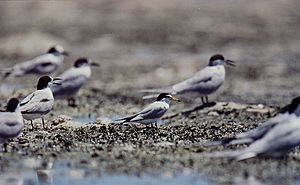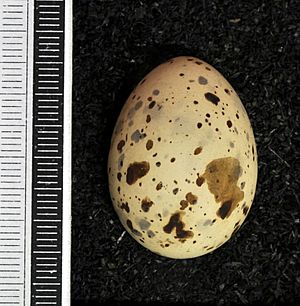Little tern facts for kids
Quick facts for kids Little tern |
|
|---|---|
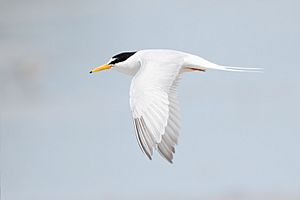 |
|
| An adult little tern in Australia | |
| Conservation status | |
| Scientific classification | |
| Genus: |
Sternula
|
| Species: |
albifrons
|
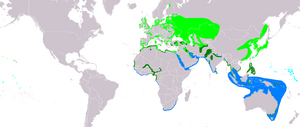 |
|
| Where the little tern lives: Breeding Resident Passage Non-breeding | |
| Synonyms | |
|
|
The little tern (Sternula albifrons) is a small seabird that belongs to the Laridae family. Its name comes from Latin words: albifrons means "white forehead." This bird was first described by a German naturalist named Peter Simon Pallas in 1764.
Some little terns that used to be considered the same species are now seen as separate. For example, the terns from North America are now called the least tern, and those from the Red Sea are called Saunders's tern.
Contents
Where Little Terns Live
This bird makes its home and raises its young along the coasts and rivers in warmer parts of Europe and Asia. Little terns are very migratory birds. This means they travel long distances. They spend their winters in warmer places like South Africa and Australia.
There are three main types, or subspecies, of little terns:
- The albifrons type lives in Europe, North Africa, and western Asia.
- The guineae type is found in western and central Africa.
- The sinensis type lives in East Asia, including Japan, Southeast Asia, the Philippines, and the coasts of Australia and New Guinea.
What Little Terns Look Like
The little tern is a small bird, about 21–25 centimeters (8–10 inches) long. Its wingspan, which is how wide its wings are when spread out, is about 41–47 centimeters (16–18 inches).
It's easy to recognize this bird because of its size and its white forehead when it's ready to breed. Its thin, sharp beak is yellow with a black tip, and its legs are also yellow. In winter, its forehead becomes even whiter, its beak turns black, and its legs are not as bright. When it calls, it makes a loud, creaking sound.
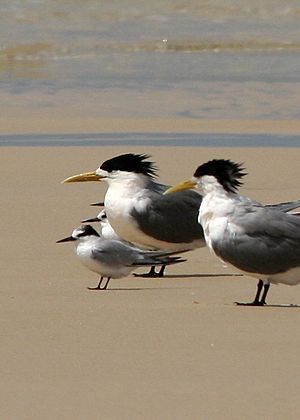
Little Tern Reproduction and Feeding
Little terns usually breed in groups called colonies. They build their nests on beaches made of gravel or small stones, often on islands. A female tern will lay two to four eggs right on the ground.
Like other white terns, they are very protective of their nests and young. If someone or something comes too close, they will try to scare them away.
Little terns eat by diving headfirst into the water to catch fish. They usually hunt in salty water. As part of their courtship display, the male tern will often offer a fish to the female. This is a way for them to show affection before they mate.
Little Tern Populations in Europe
A long time ago, in the early 1800s, the little tern was very common along European coasts, rivers, and wetlands. However, in the 1900s, their numbers started to drop. This happened because they lost their natural homes, pollution made their habitats unsafe, and people disturbed their nesting areas.
The decline was even worse for terns living along rivers. Dams, river changes, and taking sand and gravel from rivers destroyed many of their old homes. Because of this, little terns have disappeared or become very rare in many European countries. They used to breed on big rivers like the Danube, Elbe, and Rhine, but not anymore.
Today, only a few river systems in Europe still have good places for little terns to breed. These include the Loire/Allier in France, the Vistula/Odra in Poland, the Po/Ticino in Italy, the Daugava in Latvia, the Nemunas in Lithuania, the Sava in Croatia, and the Drava in Hungary and Croatia.
The little tern population on the Drava River is one of the most endangered. Old ways of managing water, like changing the river's path and removing sediment, are still a threat. Only about 15 pairs of little terns still breed on the sand and gravel banks along the border between Hungary and Croatia. Groups like the WWF are working to protect these birds and their special river home. The little tern is also protected by an agreement called the Agreement on the Conservation of African-Eurasian Migratory Waterbirds (AEWA).
Images for kids
See also
 In Spanish: Charrancito común para niños
In Spanish: Charrancito común para niños



